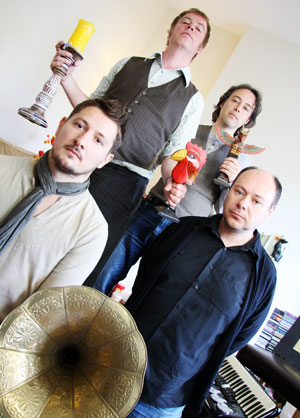 Excerpt from the Soft Hearted Scientists Manifesto:
Excerpt from the Soft Hearted Scientists Manifesto:
“WE WILL create music with a sense of wonder: like the sound of stars flying off the end of a wand or, if it were possible, the sound of plucking a spider’s web encrusted with dew drops. Nothing less will do.”
Earlier this year, Fruits de Mer Records released Whatever Happened To The Soft Hearted Scientists, a 2-LP + 7″ compilation of songs from the band’s four CDs, songs from their now released new album, False Lights, some previously unreleased demos, and a title track exclusive to the compilation. I had never heard of the band before but was instantly smitten by the magical, and, sometimes mystical blend of Psychedelia, Folk-Psych, Pop-Psych, traditional influences, Progressive Rock, and so much more that makes the music accessible to all, but ultimately difficult to adequately describe.
Soft Hearted Scientists are the Welsh quartet of Nathan Hall, Dylan Line, Paul Jones and Michael Bailey. They formed in Cardiff in 2001 as the duo of Hall and Line, making cassette demos in Hall’s house. Both had played in bands that performed live but not released any recordings. Hall explains that, “it’s only when I took time out from bands for two years and really concentrated on my songwriting that I started to crack it around 2000. And then Dylan came along with analogue synthesizers and helped to arrange some songs I’d written and it was clear they were better than anything I’d done before.”
Did any particular vision, goal or common interest bring the two musicians together? “To escape from band practice rooms and amplifiers, quiet things down and experiment with any instrument or sound and to create something we truly liked that had some kind of magic dust on it and was influenced not just by music but by books, films, anything at all.”
Magic dust indeed. I’ll continue the story by way of an overview of the Soft Hearted Scientists discography. All quotes are from Nathan Hall, who I conducted an email interview with, as well as some taken from the band’s web site…
 Uncanny Tales From The Everyday Undergrowth (2005)
Uncanny Tales From The Everyday Undergrowth (2005)
Soft Hearted Scientists debut started life as three EPs released in 2004 – Wendigo, Bethesda, and Midnight Mutinies. Why release three EPs and then bring them together for a first full album? “We worked so intensively on them that we could not face a quick follow up album so released them as our debut album. At first it seemed like an anti-climax to just glue them together, but then they took on a life of their own and the album completely took over from the EPs in our heads.”
Sure enough, the dozen songs on Uncanny Tales From The Everyday Undergrowth transition seamlessly, and one would never know they were actually taken from three different releases. It’s a psychedelically pastoral set of songs. The album opens with the song that has become one of my favorites in the entire Soft Hearted Scientists catalog – Mount Palomar. If I wanted to turn somebody on to the band and could only play one song, this would be it. It’s acoustic driven, but with a full band backing, including rhythm section, organ and freaky electronics. And when the chorus kicks in it’s like an acoustic-orchestral explosion with a joyously uplifting feel that borders on the spiritual. Its part 60s Pop-Folk-Psych, with beautiful harmonies, dashes of Progressive Rock, and wee bits of playful experimentalism. This acoustic lead, yet full band sound, utilizing various instruments and sounds characterizes much of the album. The melodies, instrumentation and arrangements will hook you on the first listen, but there’s so much going on that attentive listeners will be rewarded on multiple listens.
Along with the enchanting music, Nathan Hall’s lyrics are crucial to what Soft Hearted Scientists are about. Topics can range from bucolic, to thoughtful, to wildly surreal, and just pure fun. Diving Bell is a musing toe-tapper that includes a spoken word segment describing a dream, part of which is about Billy Ray Cyrus sitting in Satan’s waiting room and being forced to play Achy Breaky Heart surrounded by demons with flaming mullets, all retribution for the misery he inflicted on humanity with that horrible song and boot scootin’ phenomenon. Pretty wild, huh? Demons appear again in the form of the Wendigo. I love the combination of guitar melody that sounds like a Morricone soundtrack, oddball warbling synths, and multi-part vocals. I like the strange but seductive ooh-wee-ooh synths and acoustic guitars on Brother Sister. The Yongy Bongy Bo is another highlight of the set, with its blend of Pagan-Folk and Celtic, and the lyrics based on a poem by Edward Lear. Isabella (Keep Riding The Road To The Sea) is another standout, sounding like a Folk-Prog take on a gypsy influenced show tune. But then halfway through the song the band shift gears and settle into that mixture of rhythmic toe tapping, traditional pub gathering and Pop-Folk-Psych that Soft Hearted Scientists are so adept at. Dig that banjo. And Midnight Mutinies is a stunning blend of Folk-Prog and spacey freakiness.
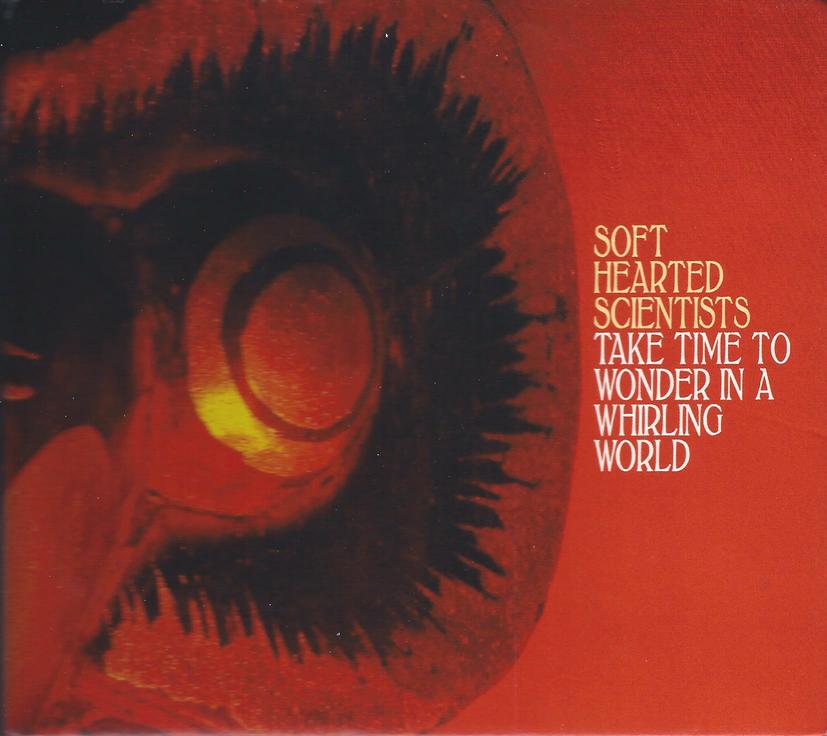 Take Time To Wonder In A Whirling World (2007)
Take Time To Wonder In A Whirling World (2007)
The A470 Song opens the album and combines radio wave electronics, luscious picking acoustic guitars, and plucked strings, and the backing vocals have a thrumming drone quality, an intriguing marriage of contrasting elements that is a common thread throughout all Soft Hearted Scientists albums. This leads into I Wanted You, which despite its delightfully bouncy feel good groove, tells of love that wasn’t meant to be. Light Years To Nothing features more of Soft Hearted Scientists brand of Pop-Folk-Psych, with the addition of more spacey electronics and atmospherics.
I shared with Nathan Hall how difficult I find it to describe their accessible yet challenging music. “I think I just wanted to get the same feeling from my own songs that I got from, say, See Emily Play, but also that feeling you get from watching some creepy old movie or seeing the face of a praying mantis – that something otherworldly was happening. And everything from psych music, to Hammer horror films, to my guilty childhood pleasure of Marvel comics all combined somehow to fuel that rather melodramatic and surreal stuff that we do. Dylan likes a lot of electronic music and BBC Radiophonic workshop stuff too.”
This response resonated with me and I think goes light years toward explaining the sense of wonder to be found from immersion in Soft Hearted Scientists music. Other highlights of the set include Siberia, with its mixture of Pop-Psych, traditional influences and Progressive Rock, plus fun strange sounds scattered throughout. Rockford’s Return is a cool grooving Space-Prog song, the only lyrics being the repetitive invitation to, as the album title says – “Take Time To Wonder In A Whirling World”. Eyes is another one of my favorite songs in the Soft Hearted Scientists catalog. It’s got a beat that will make anyone want to dance. And it takes time to wonder, as the chorus says – “When I look at you I see a lifelong dreamer. It’s in your eyes. It’s in your eyes.” And then the narrator flips it back around with – “When you look at me you’ll see a lifelong dreamer. It’s in my eyes. It’s in my eyes.”
And then there’s the 10 minute epic The Caterpillar Song, which in my review of the Fruits de Mer label compilation I described as starting off as a spaced out Folk infused Pop-Psych song and eventually builds into full blown Progressive Rock, with BIG keyboards, a ripping tripped out guitar solo, and oscillating UFO effects. It’s a monster of a track and so much is happening in 10 minutes. I thought I had read somewhere that Nathan Hall said he would like to do a 20 minute song sometime and asked him about that. “Well, we are actually working up a 12 and half minute song at the moment. But it’s really a loose collection of short bits like A Quick One or the second side of Abbey Road rather than that big song on Floyd’s Meddle which is seamless. So it does not try to hide the joins at all and starts with a quiet verse and chorus repeated twice and is very poignant, but then jumps into a faster bit with a silly lyric, then a darker bit, then a really spooky folky bit, then a very dense lyrical Beta band type bit and then ends on a more strident end part, a massive stylophone solo, and then a very quiet reprise of the second part that fades out in a really ghostly way! So God knows what a 20 minute one would do.” I’m confident they could pull it off…
 Scarecrow Smile: Home Demos Volume 1 (2009)
Scarecrow Smile: Home Demos Volume 1 (2009)
Scarecrow Smile is precisely what the sub-title says. In the CD notes Nathan Hall humorously describes how he was pestered into releasing this set by neglected songs, complaining that they deserved to be heard. These are recordings mostly dating from 2001-2005; lo-fi songs intended to showcase a side of the group that differs from the multi-layered studio recordings. To be sure, Soft Hearted Scientists studio albums are beautifully produced and arranged. But as the 16 songs on Scarecrow Smile demonstrate, the lo-fi home recordings in no way detract from the band’s charm.
The country-like bounce of Effervesce feels like something from The Beatles’ Let It Be. Simple keyboards are put to good use on songs like Man Overboard!, Twilight Eyes, The Impossible, and Return Of The Black Dahlia. I’m a fan of the 1980s homemade music cassette culture scene and have been captivated by some pretty raw stuff, so hearing simplicity manifest itself in such well-crafted songs is a pleasure. Garden Song is one of the most dreamily somber songs I’ve heard from Soft Hearted Scientists, with its vocal harmonies, acoustic guitar, piano, and eerie keyboards. Evil Eye achieves a delicate balance between frantic rushing and Psychedelic drift. There’s plenty of experimentation too as evidenced by songs like Scarecrow Smile and Totem Pole Blues, with its alien electronics rising and falling to lulling acoustic guitars. And Manta Ray on Main Street sounds like a spaced out experimental Simon & Garfunkel.
Give these guys a couple acoustic guitars, bass, drums and a simple keyboard and I’m sure they could captivate an audience all night. Which makes me wonder if this more lo-fi sound is what a live Soft Hearted Scientists experience might be like? Though primarily a studio band, I asked Nathan Hall about live performances. “Our live thing is four of us but we have not played for 18 months. It is inevitably more stripped down but that’s not a bad thing as live is different. We have never had a live drummer on a regular basis and we are considering getting one. They are like ducks teeth in Cardiff. Don’t know why.”
Calling Scarecrow Smiles: Homemade Demos “Volume 1″ implies there will be another, which I asked Nathan Hall about. “I did plan a 22 track follow up but that might be a bit much. There will be a volume 2 at some stage. There are lots of demos sitting about.” Bring it on Nathan…
 Wandermoon (2011)
Wandermoon (2011)
Wandermoon is Nathan Hall’s word for elevation and escape. As he explains on the band’s web site: “When the drudgery of life is biting I escape to beautiful places like Nash Point Lighthouse or a John Steinbeck book like Travels With Charley or the film Stand By Me. They are all Wandermoon. It’s everything important in life reduced to a single word.”
Wandermoon is the one album that includes track-by-track notes on the band’s web site, providing the listener with a bit of insight into Hall’s lyrics. It’s also a relatively short album, with six songs at just over 30 minutes. Mountain Delight is a beauty of a song about several trips Hall took to Bethesda in North Wales. “Oh brother there’s a world to see. It’s overflowing in its mystery. And when I gaze into infinity. I melt away. Life is stranger than a dragonfly. Constellations floating in the night. I sing this song to set these miracles… to memory”. The song is almost Prog style epic in its multiple thematic transitions, despite being six minutes long. The Trees Don’t Seem To Know That Its September is a lament for the end of summer, with whimsical music that conjures up images of an old variety show performance. Tornadoes In Birmingham is what Hall describes as an “ecological hallucinatory ballad”, a term I kept repeating over and over in my head because the phrase sounds so cool. I like the music’s crossover between acoustic pop and dreamy vibe . Arrival Song is about going off on holiday to sort one’s head out, communicated through gracefully fanciful music. Road To Rhayader consists of a hypnotic melody and vocals, interweaving acoustic and electric guitars and marching rhythmic pace, and all-around beautiful instrumental arrangements. Westward Leading opens with trademark Soft Hearted Scientists acoustic guitar and vocals, plus a cool sci-fi synth line, but quickly launches into a bouncy, seductively melodic Pop-Psych song. There are lots of fun effects, and I love the keyboards, which range from organ, to synths, to classic Prog style. And at 10+ minutes the music switches gears frequently, from the opening song, to cosmic Prog instrumental interludes, and more. I love the multi-part vocals backed by hypnotic organ in the last minute. Yeah, I think these guys could do interesting things with a 20 minute song.
While preparing interview questions for Nathan Hall I labored over a lot of far too detailed questions about his lyrics, and then Wandermoon prompted me to distill them down to a single question about the inspiration he draws from his surroundings. “I spent several years in Bethesda in North Wales and the countryside there had a big impact on me. The mountains and woodland. I’ve lived in Cardiff for many years but I have to get out of it most weekends for walks in special places like Nash Point and Tintern Abbey and Garwnant Forest Centre near Merthyr Tydfil. There is no doubt these walks and places have helped fuel the songs.”
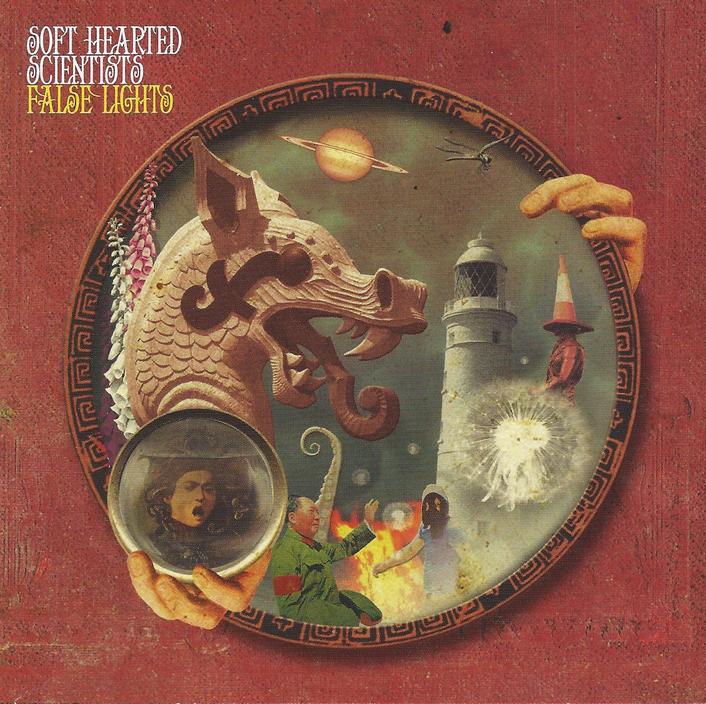 False Lights (2013)
False Lights (2013)
False Lights is the new Soft Hearted Scientists album, released in mid-May and consisting of 14 tracks at 56 minutes. The web site describes it as a companion album to Wandermoon, as well as being a darker album than previous releases. I asked Nathan Hall to elaborate on this. “False Lights has a lot of songs containing anger and darkness that necessitate the escape to the countryside to clear my head and so on. But after some darkness the clouds part at the point that Night of the Hunter suddenly speeds up and continues through Panorama. They are two very hopeful songs, and in both of them I find myself back in the countryside, with a head full of light and thinking anything is possible again despite all the unpleasant things going on in the world. So it is ultimately hopeful and those last 2 songs are companions to the much more innocent songs of Wandermoon.”
If this is a darker album you sure can’t tell from the music. Seeing conjures up images of a lively rural village festival. There’s a bit of George Harrison in the guitar, plus some trippy licks from a second guitar, both of which sound great alongside the banjo. The brief Seeing Further serves as a deep space synth dominated coda to the song. I love the Folk-Prog, haunting Psychedelia, traditional influences and electronic effects that come together so strangely but nicely on the title track. Golgotha has a lulling dreamy feel, with a body swaying rhythmic pulse and flittering space electronics, and a finale that brings to mind some of the more lysergic moments from The Beatles’ Magical Mystery Tour. I like the combination of grooving jazzy-tribal percussion and catchy guitar and piano melody on Song From The River. But listen to the lyrics, talking about Starbucks in the tomb of Tutankhamun, Tesco stores in the sphinx, and McDonalds inside every pyramid. Now those are dark thoughts!
Other highlights include Seaside Sid and the Giant Squid, with its great groove and Mellotron-ish sounding melody line. Trees In The Wind is a mind-bending song with beautiful vocals and choral backing. “I felt my world was spinning too quickly. So Pegasus flew me away.” And then, “The Chinese army were riding on horseback. Charging at atom bomb clouds.” Monsters Of The Id combines a threatening tone with spirited music and a banquet of fun sounds and effects. Night Of The Hunter is one of my favorite songs on False Lights, largely due to the feel-good transition from trippy psych song to majestic Pop-Prog-Psych with killer melodic hooks. Panorama is similar, starting off as one of the most playful songs of the set, and ending as part Pop-Psych song and part effects laden experimentation. In fact, synths and electronics make their presence especially prominent throughout False Lights.
Having immersed myself in these albums I’m struck by the variety of instrumentation and sounds and the fullness with which Soft Hearted Scientists bring it all together. The songs are beautifully arranged and produced and I wasn’t surprised to read on the band’s Facebook page that it took 250 hours of studio time to complete False Lights. I asked Nathan Hall about what it takes to record a Soft Hearted Scientists album. “The songs are fully composed beforehand. A lot of the detail of the arrangements is worked out and demo’d at home in advance so that it is a case of transferring the vision to the studio, to minimize cost and stress. However, stuff does happen spontaneously too. Seeing Further, Paul’s solos on Seeing and Panorama, the whole extension to the end part of Panorama happened in the studio at the mixing stage. Lots of the detail on Halloween People and Trees in the Wind was written after the mixes seemed to be lacking to me so I got busy with a singing saw and cheap sitar sample. Oh and the beat on Halloween People was kind of a send up of Mumford and Sons.”
Throughout their catalog, Soft Hearted Scientists prove themselves to be masters at bringing together contrasting elements and making it all sound absolutely scrumptious. Theirs is a world where synths and spaced out electronic effects become soul mates with banjos. Maybe they should have called themselves Soft Hearted Alchemists?
What’s next for Soft Hearted Scientists? “We start a new album in the next month with a view to completion at the end of next summer. We might even play live again if we get offered any decent shows. There is a vast disparity between what we have achieved in the studio and what is on offer to us live as we do not have an agent or manager. It would take more time and energy and probably cost more to do a tour than to record the next album so unless and until someone steps in to sort that kind of thing out for us we are mainly a studio entity.”
Soft Hearted Scientists would like to extend their gratitude to Fruits de Mer Records for all their support.
By Jerry Kranitz
 Crystal Jacqueline is a British musician and vocalist who has fronted such bands as Burning Ice, Hot Spice, Daylights Burning, and is singer-keyboardist in The Honey Pots. According to her Facebook page, Crystal Jacqueline has completed her first album – Sun Dance (though I’m not sure if it’s been released yet). On her first FdM single she takes on a varied trio of covers.
Crystal Jacqueline is a British musician and vocalist who has fronted such bands as Burning Ice, Hot Spice, Daylights Burning, and is singer-keyboardist in The Honey Pots. According to her Facebook page, Crystal Jacqueline has completed her first album – Sun Dance (though I’m not sure if it’s been released yet). On her first FdM single she takes on a varied trio of covers.
 Computerchemist is headed up by Dave Pearson, an English musician residing in Hungary. This time last month I reviewed the 2-part new Computerchemist album, Signatures I & II, which included Budapest based drummer Zsolt Galántai. I mention that because despite the different band name, Audio Cologne Project is in some ways a follow up to the Space meets Prog of Signatures, albeit in a different direction (
Computerchemist is headed up by Dave Pearson, an English musician residing in Hungary. This time last month I reviewed the 2-part new Computerchemist album, Signatures I & II, which included Budapest based drummer Zsolt Galántai. I mention that because despite the different band name, Audio Cologne Project is in some ways a follow up to the Space meets Prog of Signatures, albeit in a different direction (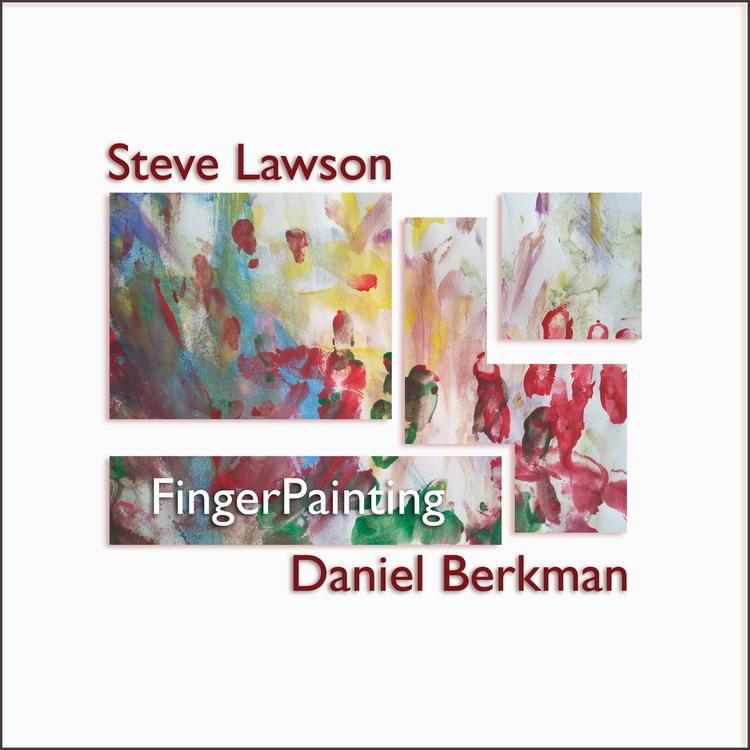 Steve Lawson is a UK based improvisational bass player whose music I’ve been acquainted with for many years. In Lawson’s hand, the bass transcends its usual role, instead being a lead instrument, a creator of atmosphere, and a brush that paints sonic landscapes. Steve has released many albums that explore realms along the jazz-ambient axis, both solo and duo collaborations. His latest is a duo set that documents one of 10 live shows that featured Lawson on fretless bass, looping, and processing, and San Francisco based musician Daniel Berkman on Gravikord (electric double harp), Kora, Ukelele, Handsonic, and synths. As is often the case with Lawson, the 10 performances were the only times the musicians played together; no rehearsals or planning. Fingerpainting was recorded in Altadena, California on January 25, 2013, the first of an 8-show January tour.
Steve Lawson is a UK based improvisational bass player whose music I’ve been acquainted with for many years. In Lawson’s hand, the bass transcends its usual role, instead being a lead instrument, a creator of atmosphere, and a brush that paints sonic landscapes. Steve has released many albums that explore realms along the jazz-ambient axis, both solo and duo collaborations. His latest is a duo set that documents one of 10 live shows that featured Lawson on fretless bass, looping, and processing, and San Francisco based musician Daniel Berkman on Gravikord (electric double harp), Kora, Ukelele, Handsonic, and synths. As is often the case with Lawson, the 10 performances were the only times the musicians played together; no rehearsals or planning. Fingerpainting was recorded in Altadena, California on January 25, 2013, the first of an 8-show January tour. Recently I reviewed a new spacerock project from UK’s Keith Hill called Oceanfire. Keith also plays in the band Civilian Zen. I can hear how he drew on his Civilian Zen experiences to create the Oceanfire sound, but Civilian Zen is a different beast altogether.
Recently I reviewed a new spacerock project from UK’s Keith Hill called Oceanfire. Keith also plays in the band Civilian Zen. I can hear how he drew on his Civilian Zen experiences to create the Oceanfire sound, but Civilian Zen is a different beast altogether. On the surface, Boise, Idaho’s Pravda would appear to be just another neo prog/prog metal band. But dig just a little past the surface and there is far more to be revealed. The Clarity of Chaos is the band’s 4th album to date, and is a concept album (naturally) about our mortality and our short time here on Earth. Formed in the early 2000’s by veteran musicians, the band has had several line-up changes since then, with the current line-up consisting of Dave Thomas on drums, percussion and vocals; John Redfield on guitars, bass and vocals and KC Thomsen on synths, piano, Hammond organ and vocals. Tom Savanoe also joins them on bass when the band plays live.
On the surface, Boise, Idaho’s Pravda would appear to be just another neo prog/prog metal band. But dig just a little past the surface and there is far more to be revealed. The Clarity of Chaos is the band’s 4th album to date, and is a concept album (naturally) about our mortality and our short time here on Earth. Formed in the early 2000’s by veteran musicians, the band has had several line-up changes since then, with the current line-up consisting of Dave Thomas on drums, percussion and vocals; John Redfield on guitars, bass and vocals and KC Thomsen on synths, piano, Hammond organ and vocals. Tom Savanoe also joins them on bass when the band plays live. German improvisational ensemble Space Debris return with their 10th album – She’s A Temple, which consists of 8 instrumental tracks and a full 77 minutes of music. The band are the quartet of Tommy Gorny on guitar, Mitja Besen on bass, Winnie Rimbach-Sator on keyboards, and Christian Jäger on drums & percussion.
German improvisational ensemble Space Debris return with their 10th album – She’s A Temple, which consists of 8 instrumental tracks and a full 77 minutes of music. The band are the quartet of Tommy Gorny on guitar, Mitja Besen on bass, Winnie Rimbach-Sator on keyboards, and Christian Jäger on drums & percussion. Giöbia are an Italian band I first discovered years ago through their 2004 Beyond The Stars album. In my review I described them as like Ozric Tentacles or Ship Of Fools being more song-oriented and with female vocals. Fast forward nearly a decade and we have their new album on Sulatron Records – Introducing Night Sound. Still with the band are Stefano Bazu Basurto on guitars, sitar, bouzouki and vocals, Paolo Detrji Basurto on bass (he played percussion and synths on the earlier album), and Stefano Betta on drums and percussion. And we now have Saffo Fontana on organ, synth, violin and vocals.
Giöbia are an Italian band I first discovered years ago through their 2004 Beyond The Stars album. In my review I described them as like Ozric Tentacles or Ship Of Fools being more song-oriented and with female vocals. Fast forward nearly a decade and we have their new album on Sulatron Records – Introducing Night Sound. Still with the band are Stefano Bazu Basurto on guitars, sitar, bouzouki and vocals, Paolo Detrji Basurto on bass (he played percussion and synths on the earlier album), and Stefano Betta on drums and percussion. And we now have Saffo Fontana on organ, synth, violin and vocals.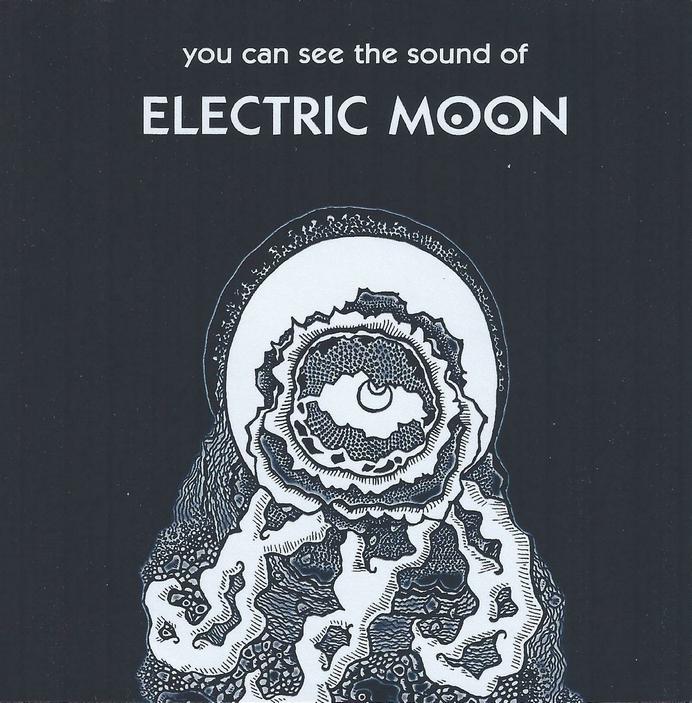 The latest from German cosmonauts Electric Moon is a 10″ vinyl release in a pressing of 500. The band are the trio of Sula Bassana on guitar, organ and synths, Komet Lulu on bass and vocals, and Michael Orloff on drums.
The latest from German cosmonauts Electric Moon is a 10″ vinyl release in a pressing of 500. The band are the trio of Sula Bassana on guitar, organ and synths, Komet Lulu on bass and vocals, and Michael Orloff on drums. Excerpt from the Soft Hearted Scientists Manifesto:
Excerpt from the Soft Hearted Scientists Manifesto: Uncanny Tales From The Everyday Undergrowth (2005)
Uncanny Tales From The Everyday Undergrowth (2005) Take Time To Wonder In A Whirling World (2007)
Take Time To Wonder In A Whirling World (2007) Scarecrow Smile: Home Demos Volume 1 (2009)
Scarecrow Smile: Home Demos Volume 1 (2009) Wandermoon (2011)
Wandermoon (2011) False Lights (2013)
False Lights (2013) The latest from Houston, Texas’ psychedelic, stoner, metal, ass kickin’ rockers LP4 is a three song 7″ vinyl EP they call Find What You Love And Let It Kill You, which apparently came from advice given to the band by Kinky Friedman. Side 1 consists of The Road, a mellow but rocking psych song with a nice melody and a dreamy flowing vibe. The bell-like keyboard melody gives it a “gentler” feel than what’s usually heard from the LP4. Good song. Side 2 includes two songs, starting with USA, which dispenses with the mellow stuff and punks out for a brief 1.5 minutes. The band shift gears again for La Jetée, an even mellower and again melodic song that’s almost folk-psychy, and has pleasant dual vocals by Ramon Medina and guest Mlee Marie. Three songs, short and sweet. The record will be released on July 8th, so mark your calendar to get a chunk of LP4 wax. Note that if you’re in the Houston area there will be a record release show on July 20th at 7pm at the Vinal Edge record store.
The latest from Houston, Texas’ psychedelic, stoner, metal, ass kickin’ rockers LP4 is a three song 7″ vinyl EP they call Find What You Love And Let It Kill You, which apparently came from advice given to the band by Kinky Friedman. Side 1 consists of The Road, a mellow but rocking psych song with a nice melody and a dreamy flowing vibe. The bell-like keyboard melody gives it a “gentler” feel than what’s usually heard from the LP4. Good song. Side 2 includes two songs, starting with USA, which dispenses with the mellow stuff and punks out for a brief 1.5 minutes. The band shift gears again for La Jetée, an even mellower and again melodic song that’s almost folk-psychy, and has pleasant dual vocals by Ramon Medina and guest Mlee Marie. Three songs, short and sweet. The record will be released on July 8th, so mark your calendar to get a chunk of LP4 wax. Note that if you’re in the Houston area there will be a record release show on July 20th at 7pm at the Vinal Edge record store.